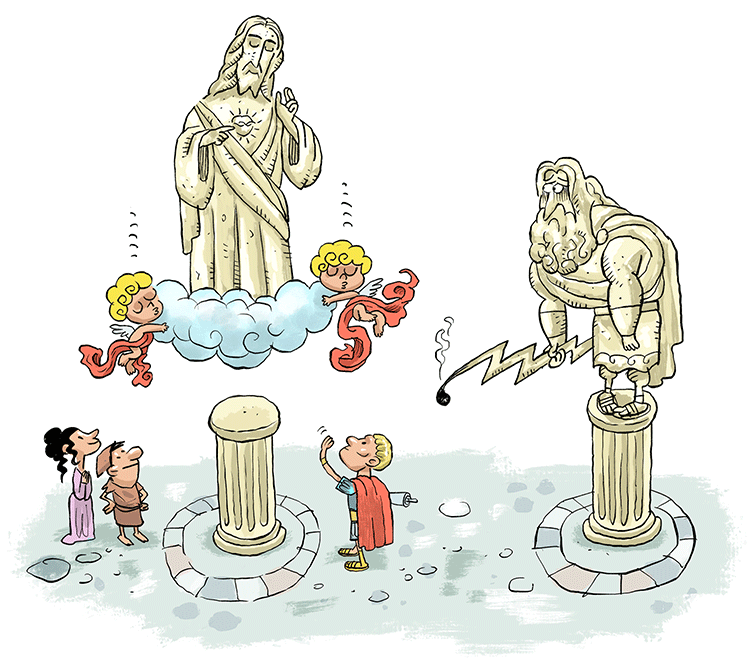When they attach “the Great” to your name, it should mean you’re a pretty big deal, no?
Ultimately, that’s up for interpretation. These titles are bestowed on leaders by historians of the time or even by themselves. We carry them on as a way of distinguishing them.
In most cases, these names are somewhat well-deserved. These individuals played a key role in some important development of the human story. Great doesn’t always need to mean good. It can just mean important.
When it comes to Constantine the Great, there’s no doubt he had a significant impact on the course of Roman history. Taking a bold claim to be emperor all the way to the top could be enough on its own, but some of his decisions wound up having a profound impact on the entirety of Rome.
Rome’s New Capital
Shortly after defeating all of his rivals, including his former ally Licinius, Constantine set out to build his capital. Considering this is the Roman empire, Rome would seem to be an obvious choice. But it was actually a terrible one.
While Rome remained an important cultural and political center, the reality was that, by the third century, the eastern parts of its empire were more prosperous and, let’s face it, more important than those in the west.
There were more people, and the civil wars affected the west more, leaving it poor and demolished. To maintain control of his empire, Constantine decided to be closer to its heart.
He took Byzantium, which was originally a Greek settlement in what is now Istanbul, Turkey, and made it his capital. The name? Constantinople, of course! At the time, it was officially called “New Rome,” but this name didn’t stick. It remained Constantinople until the 20th century.
The city’s strategic location was an obvious reason for the choice. It was much closer to the main cities of the east. But it was also already being built up by Romans. Constantine’s investment accelerated an existing process and quickly turned the city into a bustling center of commerce, politics, and arts.
This decision to refocus on the east most certainly came at the expense of the west. Depopulated and difficult to defend against invasions from the north, moving the capital in a way sealed the fate of the Western Roman Empire. It would never again shine as the center of its own vast holdings.
Administrative Reform Under Constantine
As is usually the case when a new leader steps in, Constantine did his fair share of mixing things up once he became emperor. He catered to the empire’s elites by making certain political offices only open to members of the Senate. Previously, anyone could hold these offices, which made them more difficult to control.
At this point in Roman history, the Senate had little actual power. But it did hold influence in other ways. Access was still limited and its members had considerable say in matters of business and politics across the empire. Allowing them even just a little more authority helped Constantine consolidate his power and build a more powerful state, one that could hold together in the face of so many challenges.
He also reorganized many of the bureaucracies in the provinces and appointed new people to powerful positions. This made the Roman government more efficient but also more dependent on Constantine himself.
The Church and the State Becoming One
Today, it’s not uncommon to hear people talking about “separation of church and state.” But the reality is that this is a relatively new concept in human history. For most of time, religion and government have been deeply connected.
Things were no different in the Roman empire. However, what Constantine did changed the course of history.
What was so earth shaking?

In a few words, he accepted Christianity.
The rapidly growing religion had long been condemned by the Romans, but it continued to grow nonetheless. Constantine promised religious freedom for Christians in his Edict of Milan issued in 313 AD, and he also converted to Christianity himself.
Although not everyone in the Roman government was a Christian, Constantine’s combination of the Christian religion and Roman government made it possible for this already rapidly expanding religion to grow even more quickly and exert its influence on the entire empire.
Rome After Constantine: Trying to Keep the Empire Together
Constantine’s rise to power and subsequent reign as emperor brought peace to an empire wrought with unrest. But this peace rested entirely on his shoulders.
After his death in 337 AD, there was yet another crisis. His three sons, Constantine II, Constantius II, and Constans I were supposed to take over and continue what is often called the “Constantine dynasty.”
But civil war eventually broke out amongst them and thrust the empire into turmoil. Constantius emerged victorious from this civil war, but he was soon defeated by a man named Julian.
Eventually, Julian, Rome’s last non-Christian emperor and a powerful general with history fighting in Persia (modern Iran), took over and ruled both Eastern and Western Rome. But again only for a brief time. The west was doomed to fall.
The fourth century (300 – 399AD) turned out to mark a real split in Roman history. The west declined rapidly and became the target of increasingly frequent attacks from Germanic and Celtic tribes in the north.
No one wanted to just give up, so the fighting continued, drawing resources away from the west and making it much more difficult to defend and maintain.
Rome itself would fall in 410 AD, and the Western Roman Empire followed in 476 AD. What the world knew of its empire would continue on in the east, from its capital, named for its founder, Constantinople.
Written by Matthew Jones
Illustrated by Jean Galvao
